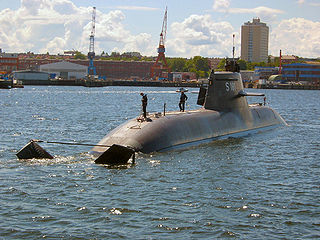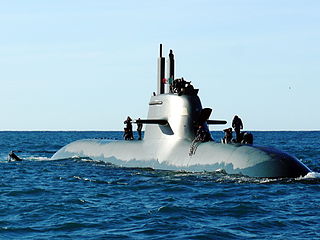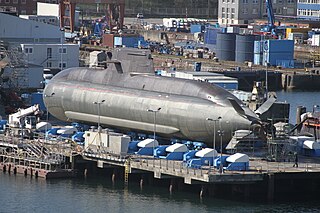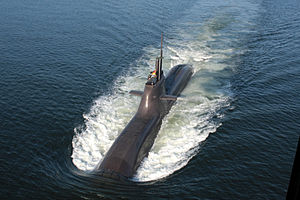
The German Navy is the navy of Germany and part of the unified Bundeswehr, the German Armed Forces. The German Navy was originally known as the Bundesmarine from 1956 to 1995, when Deutsche Marine became the official name with respect to the 1990 incorporation of the East German Volksmarine. It is deeply integrated into the NATO alliance. Its primary mission is protection of Germany's territorial waters and maritime infrastructure as well as sea lines of communication. Apart from this, the German Navy participates in peacekeeping operations, and renders humanitarian assistance and disaster relief. It also participates in anti-piracy operations.

U-boats were naval submarines operated by Germany, particularly in the First and Second World Wars. Although at times they were efficient fleet weapons against enemy naval warships, they were most effectively used in an economic-warfare role and enforcing a naval blockade against enemy shipping. The primary targets of the U-boat campaigns in both wars were the merchant convoys bringing supplies from Canada and other parts of the British Empire, and from the United States, to the United Kingdom and to the Soviet Union and the Allied territories in the Mediterranean. German submarines also destroyed Brazilian merchant ships during World War II, causing Brazil to declare war on both Germany and Italy on 22 August 1942.

German submarine U-2 was a Type IIA U-boat of Nazi Germany's Kriegsmarine. Her keel was laid down 11 February 1935 by Deutsche Werke of Kiel as yard number 237; she was launched on 1 July and commissioned on 25 July 1935 with Oberleutnant zur See (Oblt.z.S.) Hermann Michahelles in command.

The Type 212A is a class of diesel-electric submarine developed by Howaldtswerke-Deutsche Werft AG (HDW) for the German Navy, and the Italian Navy where it is known as the Todaro class. It features diesel propulsion and an additional air-independent propulsion (AIP) system using Siemens proton exchange membrane (PEM) compressed hydrogen fuel cells. The submarines can operate at high speed on diesel power or switch to the AIP system for silent slow cruising, staying submerged for up to three weeks with little exhaust heat. The system is also said to be vibration-free and virtually undetectable.
Air-independent propulsion (AIP), or air-independent power, is any marine propulsion technology that allows a non-nuclear submarine to operate without access to atmospheric oxygen. AIP can augment or replace the diesel-electric propulsion system of non-nuclear vessels.

The Type 206 is a class of diesel-electric submarines (U-boats) developed by Howaldtswerke-Deutsche Werft (HDW). Its design is based on the preceding Type 205 submarine class. These small and agile submarines were built during the Cold War to operate in the shallow Baltic Sea and attack Warsaw Pact shipping in the event of military confrontation. The pressure hulls were built out of non-magnetic steel to counter the threat of magnetic naval mines and make detection with MAD sensors more difficult. The low emission profile allowed the submarines in exercises to intrude even into well-protected opposing forces such as carrier formations with their screen.

The Gotland-class submarines of the Swedish Navy are modern diesel-electric submarines, which were designed and built by the Kockums shipyard in Sweden. They are the first submarines in the world to feature a Stirling engine air-independent propulsion (AIP) system, which extends their underwater endurance from a few days to weeks. This capability had previously only been available with nuclear-powered submarines.

The F125 Baden-Württemberg-class frigates are a series of frigates of the German Navy, which were designed and constructed by ARGE F125, a joint-venture of Thyssen-Krupp and Lürssen. The Baden-Württemberg class have the heaviest displacement of any class of frigate worldwide. They have replaced the Bremen class. They are primarily designed for low and medium intensity maritime stabilization operations, where they are supposed to provide sea-to-land tactical fire support, asymmetric threat control at sea and support of special forces.

U-31 (S181) is a Type 212A submarine of the German Navy, and the lead ship of her class.

SM UB-46 was a Type UB II submarine or U-boat for the German Imperial Navy during World War I. UB-46 operated in the Mediterranean and the Black Seas, and was sunk by a mine in December 1916.
SM UB-19 was a German Type UB II submarine or U-boat in the German Imperial Navy during World War I. The U-boat was ordered on 30 April 1915 and launched on 2 September 1915. She was commissioned into the German Imperial Navy on 16 December 1915 as SM UB-19. The submarine sank 13 ships in 15 patrols for a total of 10,040 gross register tons (GRT). UB-19 was sunk in the English Channel at 49°56′N2°45′W on 30 November 1916 by British Q ship HMS Penshurst.
SM UB-22 was a German Type UB II submarine or U-boat in the German Imperial Navy during World War I. The U-boat was ordered on 30 April 1915 and launched on 9 October 1915. She was commissioned into the German Imperial Navy on 2 March 1915 as SM UB-22. The submarine sank 27 ships in 18 patrols for a total of 16,645 gross register tons (GRT). UB-22 was mined and sunk in the same incident with the torpedoboat SMS S16 in the North Sea at 54°40′N6°32′E on 19 January 1918 in a British minefield.

O 19, laid down as K XIX, was an O 19-class submarine of the Royal Netherlands Navy that saw service during World War II. O 19, along with her sister ship O 20, were the first submarines in the world to be equipped with a submarine snorkel that allowed the submarine to run its diesel engines while submerged.

Scirè is a Todaro-class submarine of the Italian Navy. The submarine was laid down on 27 July 2000 at the Muggiano shipyard by Fincantieri. Scirè was launched on 18 December 2004 and commissioned on 19 February 2007.

German submarine U-162 was a Type IXC U-boat of Nazi Germany's Kriegsmarine during World War II.

U-36 (S186) is a Type 212A submarine of the German Navy. She is the sixth ship of the class to enter service.

U-34 (S184) is a Type 212A submarine of the German Navy. She is the fourth ship of the class to enter service.

U-33 (S183) is the third Type 212A submarine of the German Navy.

U-35 (S185) is a Type 212A submarine of the German Navy. She is the fifth ship of the class to enter service.
German submarine U-876 was a long-range Type IXD2 U-boat built for Nazi Germany's Kriegsmarine during World War II.















